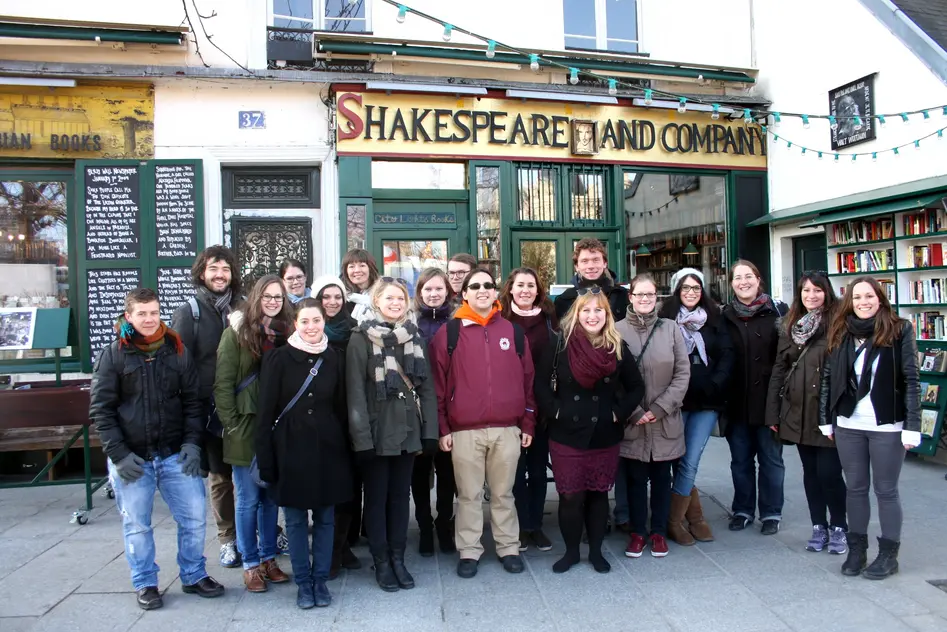One Week in Paris: American Modernism in the French Capital
by Laura Utmann (Bamberg)

"If you are lucky enough to have lived in Paris as a young man, then wherever you go for the rest of your life it stays with you, for Paris is a moveable feast."
(Ernest Hemingway, A Moveable Feast)
The Roaring Twenties were one of the most fascinating decades in American literature and art. At the time, many American writers made their way to Paris to find inspiration and to work among the greatest artists of their generation. During an excursion to Paris, organized in connection with a seminar on the topic of American Modernism in Paris, we followed the footsteps of F. Scott Fitzgerald, Gertrude Stein, Ernest Hemingway, Djuna Barnes and many other American expatriates, trying to find out why the city was so special to them.

Paris – A Home for Modernist Literature
We started our search for the magic of inter-war Paris with a literature walk through the Left Bank, which took us back in time to the Paris of modernist writers, their supporters and followers. We visited the places where some of our favorite American authors lived, loved and worked: Ernest Hemingway's first apartment, Gertrude Stein's and Natalie Clifford Barney's literary salons, and the original site of Sylvia Beach's legendary bookstore Shakespeare & Company, as well as its successor, where we had a reading of excerpts from Ulysses and other famous books of the era.
For a, quite literally, different view on Paris during the 1920s and 30s, we went to the Forum des Images, a paradise for film lovers, which gives visitors access to a large collection of audiovisual documents about the city. Together with our truly passionate guide, we watched a movie about two American dancers and their rise to fame in Paris before WWII as well as several stunning short documentary clips of Paris during that time.
Paris – The Birth Place of Modernist Art
Another focus of our trip was the illustrious group of Modernist artists that lived in Paris alongside the American expatriate writers. A guided walk led us through Montmartre, a quarter not only known for its basilica Sacré Cœur, but also as a place where painters like Pablo Picasso, George Braque, Henri Matisse and Vincent Van Gogh gathered, drawing inspiration from the vibrant artist community at the 'Right Bank.'
For a first-hand look at the works of theses artists – and certainly also to defrost after our long walks through mid-February Paris – we visited the Centre Pompidou, the largest museum of modern art in Europe. Impressed and intrigued, many of us later also went to the Musée d’Orsay, which displays a large number of impressionist and post-impressionist paintings and thus shows the French art scene from which the modern(ist) art we were interested in developed at the beginning of the 20th century.
Paris – A Place of Rest and Restlessness
Because everything has to end, one of the last stops on our trip was the cemetery Père Lachaise, where Gertrude Stein and numerous other Americans of her period lie buried. "America is my country and Paris is my hometown," Stein once said. She never left Paris, and neither did other famous Americans like Isadora Duncan, the mother of modern dance, African American author Richard Wright, or rock star James Morrison.


Of course, Paris has always been much more a place for the living, a fact that rings particularly true for the Années Folles of the 1920s. During what may well have been the city’s most decadent decade, it was the glittering capitol of the world, home to adventurous expatriates, eccentric artists, their glamorous companions and, last but not least to Jazz! Brought to France by mostly African American musicians, Jazz took Paris by storm, which is why we listened to Jazz pieces by Josephine Baker ("Bye Bye Blackbird"), Django Reinhardt ("Carinosa"), and many others.
Much to the surprise of passing Parisians, our little Jazz-session took place in a metro station ("Sacrément! Les Allemands!") on our way to the "The Melting Pot Stand Up Comedy Night" at the Théatre des Dix Heures, where comedians of different nationalities had us laugh at all the things that can happen to you (not only, but especially) as American in Paris.
Paris – A Place of Magic
I think I can say that we all had a really great time in Paris. While we were staying in an America-themed hotel with the very un-American name Hotel République, we learned a lot about American expatriates in Paris and the artistic circles in which they moved.
Paris was a magnificent place to be between the world wars, a place where writers and artists could live exiting lives and make extraordinary careers. Almost a century later, Paris still has not lost this magic. Its streets and riverbanks, bookstores and museums, cafés and (night)life, and all the people who keep coming there – everything contributes to a charm that made Paris special to American expatriates in the 1920s and still makes it special for us today.





